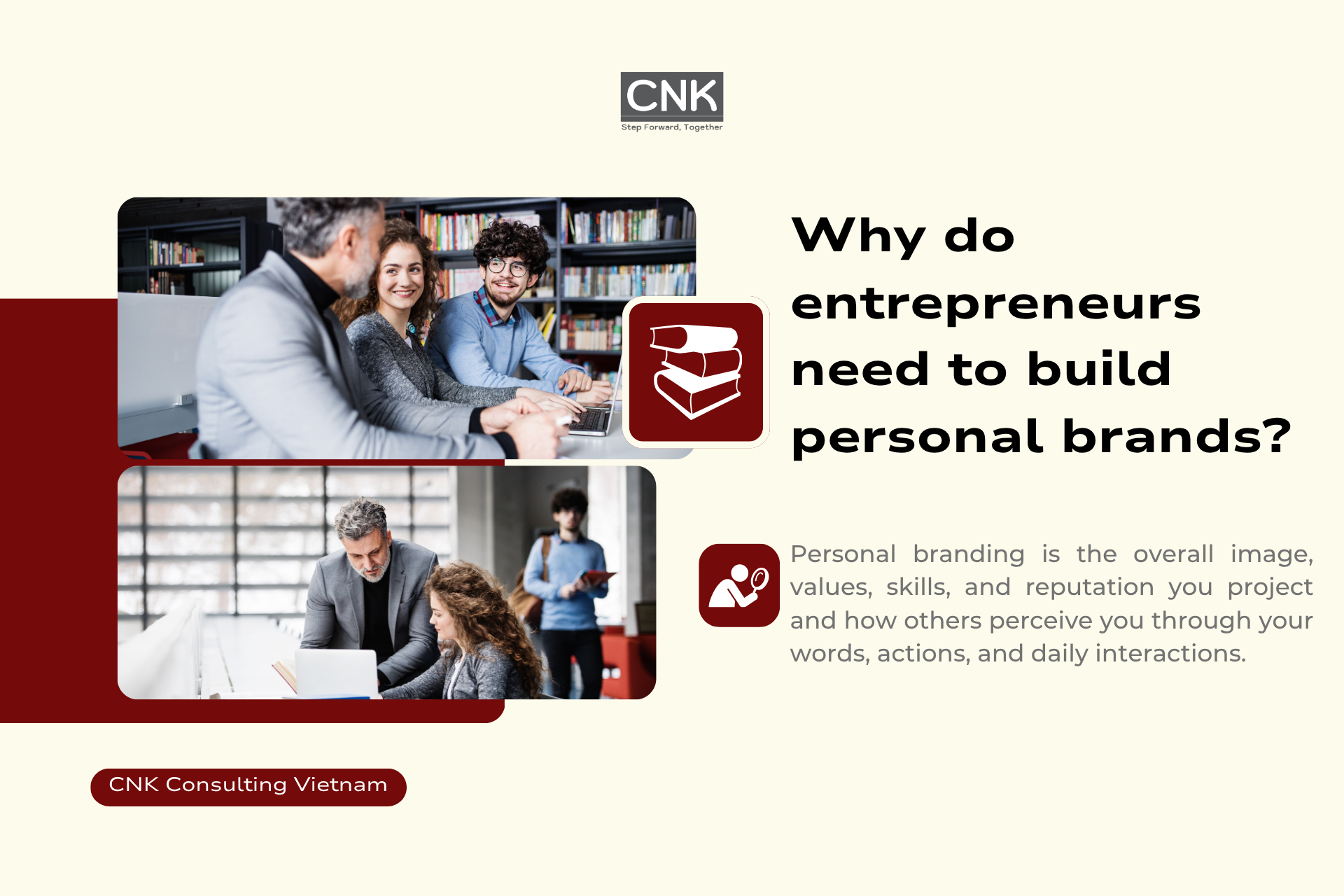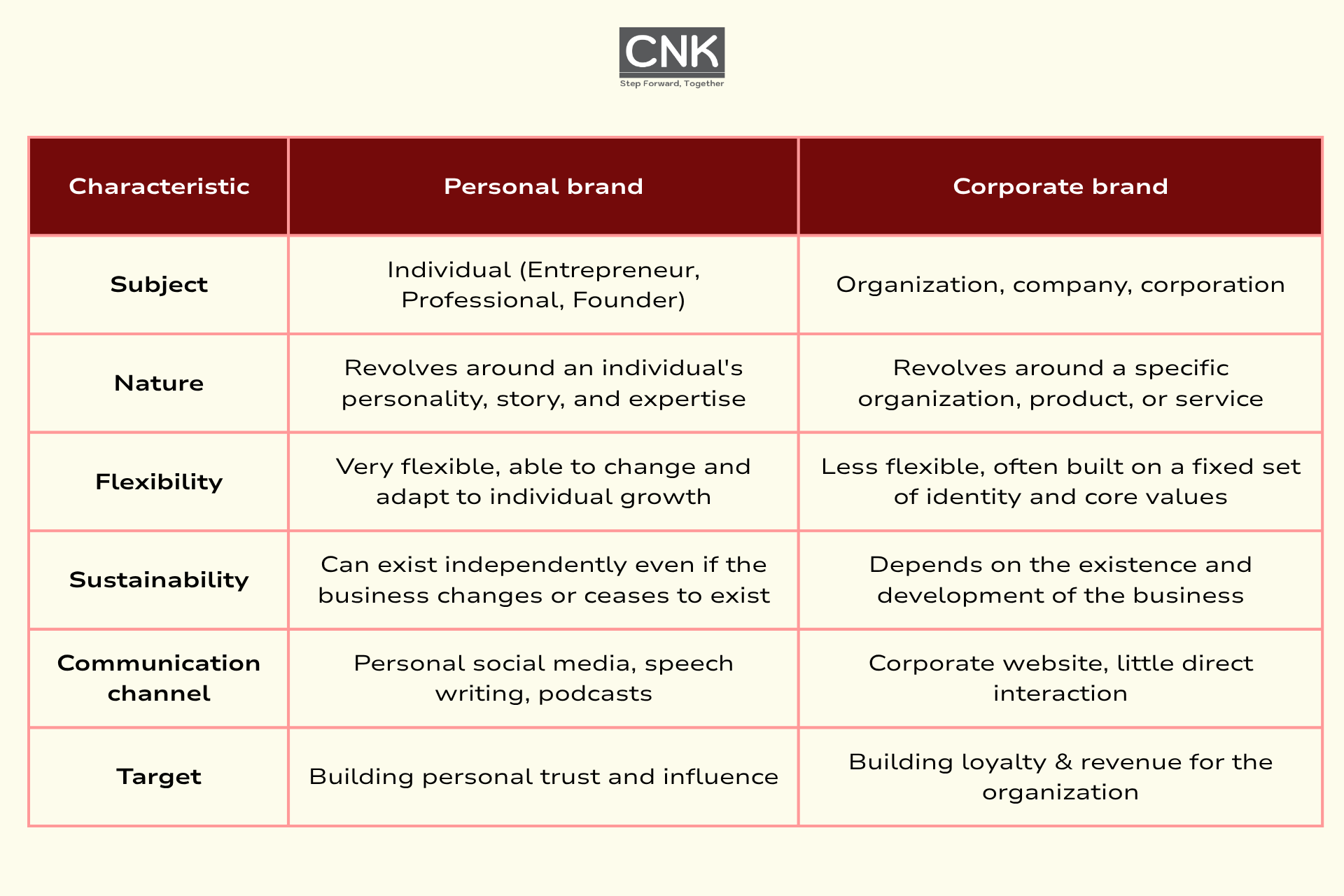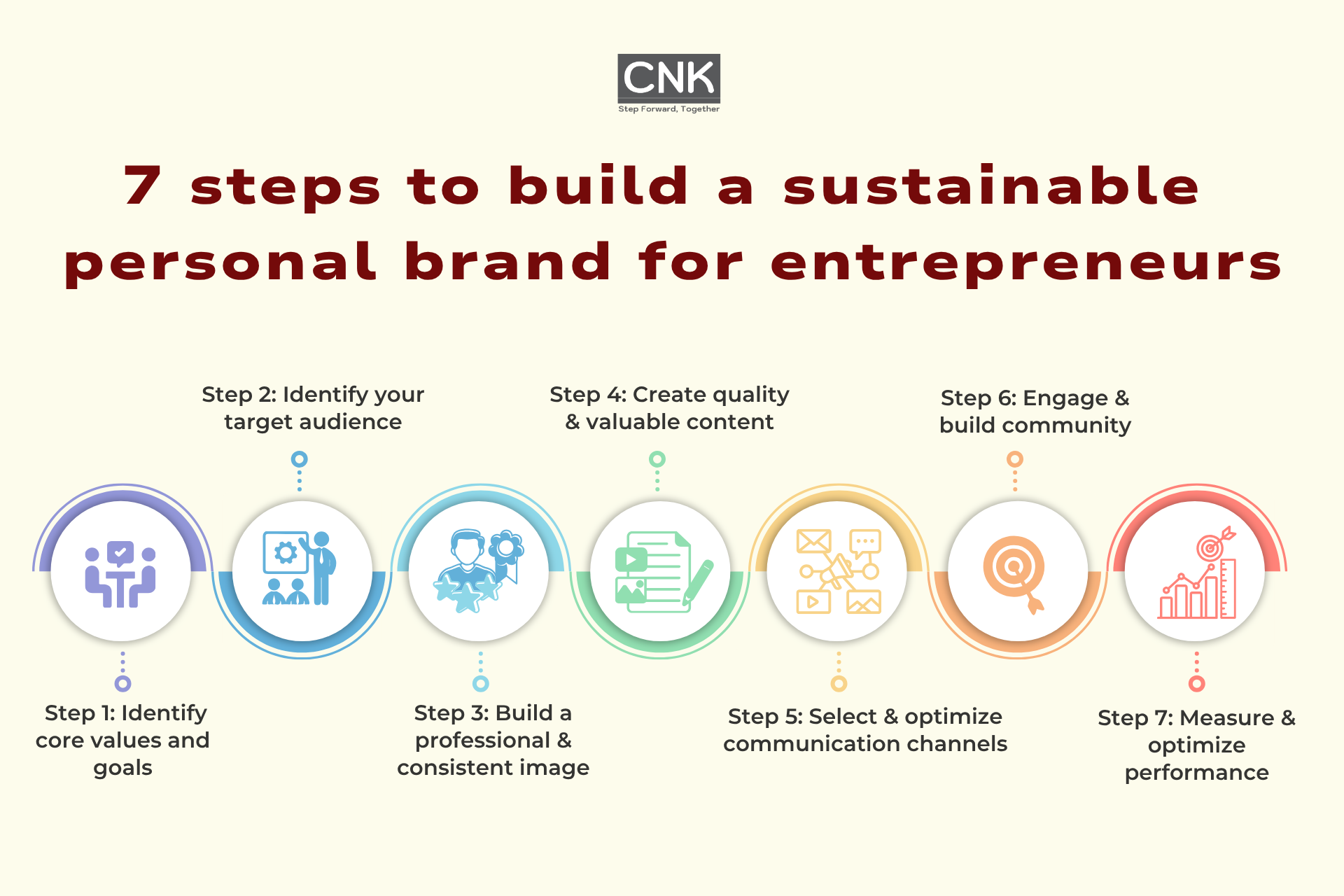Personal branding for entrepreneurs is not only an advantage but has become a mandatory requirement to assert their position in the market. A strong personal brand helps entrepreneurs create a distinctive mark, attract quality compound opportunities and enhance the trust of customers and investors. This article will provide you with core strategies to develop your personal economy in a systematic, professional and effective way.
Table of Contents
- 1 Why do entrepreneurs need to build personal brands?
- 2 7 steps to build a sustainable personal brand for entrepreneurs
- 2.1 Step 1: Identify core values and goals
- 2.2 Step 2: Identify your target audience
- 2.3 Step 3: Build a professional and consistent image
- 2.4 Step 4: Create quality and valuable content
- 2.5 Step 5: Select and optimize communication channels
- 2.6 Step 6: Engage and build community
- 2.7 Step 7: Measure and optimize performance
- 3 Mistakes to avoid when building a personal brand
- 4 Conclude
Why do entrepreneurs need to build personal brands?

What is personal branding?
Personal branding is the sum total of the image, values, personality, skills and reputation that an individual projects and is remembered by others. Personal branding is not just how you “promote” yourself, but also how others actually feel about you through your words, actions, leadership style and daily interactions.
For example, an entrepreneur might be known as a pioneer in green technology, a disruptive thinker, and a strong business ethic. This is their personal brand in the eyes of the public and their partners.
The Importance of Personal Branding for Entrepreneurs
Building a personal brand is no longer an option, but a mandatory requirement for every entrepreneur who wants to succeed and develop sustainably. Here are the core reasons:
- Increase credibility and trust: Customers today buy products from people they trust. A business with a strong personal brand creates an emotional connection, builds trust, and thus makes customers feel more secure when collaborating or purchasing products and services.
- Increase sales and attract potential customers: Personal branding is an extremely effective marketing “lever”. When you become an expert in your field, potential customers will come to you. This significantly reduces traditional advertising and marketing costs, while creating a sustainable and natural marketing channel.
- Attract and retain talent: Great talent is always looking for leaders with vision, influence and credibility. When your personal brand is strong enough, you will attract the best candidates, helping to build a strong team to grow the business together.
- Create a competitive advantage: There may be hundreds of competitors in the market offering similar products. However, only you have a unique story, experience and personality. Personal branding is the key differentiator that helps you completely separate yourself from your competitors and create a unique position in the market.
>> Learn More: A Starter Guide to Personal Branding for Students
Distinguishing between personal branding and corporate branding
Although both serve the purpose of positioning value and building trust with the public, personal branding and corporate branding have completely different natures and development strategies. Understanding the difference between these two concepts not only helps entrepreneurs avoid confusion in image building, but also know how to optimize the synergy between individuals and organizations. Below is a detailed comparison table to clarify this distinction:

Personal branding and business branding are not opposites but complement each other. A good entrepreneur will build personal branding as a soft asset alongside the development of the business.
7 steps to build a sustainable personal brand for entrepreneurs
To build a solid business empire, today’s entrepreneurs cannot ignore building a personal brand – an intangible asset but has a strong influence on image, reputation and long-term development opportunities. Below are 7 steps to build a personal brand for entrepreneurs in a systematic, strategic and sustainable way that you can start today.

Step 1: Identify core values and goals
Defining your core values and goals is an essential foundation when starting to build your personal brand. If you do not understand who you are and where you want to go, others will not understand and trust you. Please answer the following questions:
- Self-discovery questions: Dig deep into your passions, skills, and expertise. What makes you unique? What can you share confidently and passionately?
- Brand positioning question group: What field do you want to be known as an expert in? For example: Do you want to be a digital marketing expert for the F&B industry, or an inspirational speaker about startups?
- Set clear goals: What are your goals in building your personal brand? Increase sales, attract talent, or become an influential speaker? The more specific your goals are, the clearer your roadmap will be.
Once you have clearly defined your values and desired destination, you can build a strategic and sustainable personal brand.
Step 2: Identify your target audience
One of the most important elements of personal branding for entrepreneurs is knowing who you are speaking to. Identifying the right target audience will help you focus your resources and create more effective content. You need to identify:
- Ideal customer profile: Who are the customers you want to serve? What industry do they work in, what are their ages, interests, and behaviors?
- Their needs: What information, solutions, or inspirational stories are they looking for? Once you understand this, you can create content that speaks to them.
Step 3: Build a professional and consistent image
When building a personal brand, your visual image is the first point of contact that helps others form an initial impression of you. If your image is inconsistent or unprofessional, it will be difficult to build trust, no matter how good your abilities are.
You need to synchronize your personal image, from your profile picture, introduction, identity colors to the fonts used. All need to express the same personality, style and brand positioning that you are aiming for. Consistency on platforms such as LinkedIn, Facebook, personal websites or even the way you appear at events all contribute to strengthening your professional image in the eyes of the public.
Tell your brand stories through personal experiences. Don’t be afraid to share your journey, including your failures, challenges, and milestones. Real stories make you more authentic, relatable, and relatable to your followers, adding depth to your personal brand.
Step 4: Create quality and valuable content
If your personal brand is a “world”, content is the bridge that helps others enter that world. Content not only helps you spread your personal message, but also serves as a means to affirm your abilities, share values and build trust with the community. It is important that you do not create content just to be present, you need to impress, create connections and retain followers.
So how do you make sure the content you create is truly valuable and reflects the personal brand you are building? Here are two key elements to keep in mind:
- Diversify your content formats: Choose formats that suit your personal style and the platform you are using. You can write in-depth blogs on your website or LinkedIn, post short videos on Tiktok or Instagram Reels, organize Livestreams on Facebook or Youtube. Diversifying your content formats will help you reach different audiences while still maintaining flexibility.
- Choose topics that are professional and practical: Your content should revolve around topics that you have real expertise or experience in. For example, you can write about lessons learned from each project, stories of failures and how you overcame them, your personal perspective on industry trends, or simply respond to common questions from your followers. This is how you become a follower, not just a presence.
Consistently sharing valuable, unique content will gradually build credibility and trust, two core elements of a strong and sustainable personal brand.
Step 5: Select and optimize communication channels
Once you have good content, you need to share it in the right place, at the right time, and in the right way to reach the right audience. In the era of strong development of 4.0 technology, the important thing is not to be everywhere, but to appear strategically in the most appropriate place. You can apply the following 2 principles:
- Identify the right media platform: Each social media channel has its own user base and different content approach. For example, if you operate in the B2B field or a highly specialized consultancy, LinkedIn is the ideal environment to demonstrate your capabilities and expand your professional network. On the other hand, if you build a personal brand aimed at individual B2C customers, share intimate stories or inspirational content, Tiktok, Instagram, or Facebook platforms will be more effective choices.
- Optimize content according to search criteria: Don’t forget that platforms like Google, Youtube or other social networks all have their own algorithms to distribute content. Using appropriate keywords, writing clear descriptions, inserting ALT tags for images, and optimizing video titles will help your personal brand be found more easily in today’s competitive digital environment.
Remember that consistency in messaging and style across different media channels will help reinforce your personal brand image as strong and trustworthy in the eyes of your followers.
Step 6: Engage and build community
A strong personal brand is not only built on what you share, but also on how you listen, connect, and create value in return. In today’s digital world, where everyone has a voice, the ability to engage and build real relationships is what separates those who are present from those who are influential. This is the transition from one-way broadcasting to creating a continuous dialogue. And to do that, you need to invest time, sincerity, and initiative in the following two activities:
- Participate actively in professional communities: Find groups, forums, seminars (Offline & Online) where the audience you want to connect with, including potential customers, partners, consultants or influencers in the industry, is present. Participating in discussions, asking questions or sharing opinions not only helps to enhance your personal reputation but also expands your network naturally and effectively.
- Organize valuable interactive activities: If you already have a certain number of followers, proactively create a space for connection by organizing thematic livestreams, mini workshops or Q&A series. This is not only an opportunity for you to convey knowledge, but also a way to create attachment, turning followers into advocates for your personal brand.
In the process of building a personal brand for entrepreneurs, effective interaction is the stepping stone that helps you move from a content sharer to a leader, and that is the next level in the journey to creating sustainable influence.
Step 7: Measure and optimize performance
Personal branding is not a short-term campaign, but a long-term journey that requires constant adjustments based on real-world feedback. You need to measure and evaluate your performance regularly to see if you are on the right track or need to adjust your content.
- Track relevant metrics: Depending on your personal branding goals (Building credibility, Finding customers, Expanding influence, etc.), choose metrics that reflect effectiveness. For example: Growth in followers, engagement on each channel (Like, Share, Comment, etc.), visits to personal website, conversion rate from content to action (Registration, Purchase, Appointment, etc.)
- Analyze and adjust your strategy: Based on the data you collect, regularly review your content, communication channels, posting frequency, and how you interact with your community. Content that performs well should be approached and further optimized. Conversely, content that is underperforming or deviates from your brand’s direction should be changed promptly.
Personal branding is not only built with images and content but also with strategic thinking. Continuously measuring, learning and adjusting helps you not only maintain your presence but also elevate your position, creating sustainable value in the eyes of the community.
Mistakes to avoid when building a personal brand
In the process of building a personal brand, many entrepreneurs make mistakes that seem small but can reduce their reputation or cause their brand development strategy to deviate. Below are 3 common mistakes that you should especially avoid if you want to build a sustainable and in-depth personal brand.
>> Learn More: Personal Branding for Real Estate Agents: Stand Out & Sell
Trying to be someone you’re not
This is one of the most common and serious mistakes. Many people see other people as successful role models and try to copy them mechanically. For example, they act calm when they are actually active, or they try to say things that are not their true opinions. This lack of authenticity makes followers feel fake, leading to distrust and an inability to connect deeply.
Lack of consistency in content and images
Consistency is key to building trust. When you post content that is inconsistent in topic, style, or even frequency, you confuse your followers. They don’t know who you are or what you stand for. This inconsistency not only reduces the effectiveness of your promotional efforts, but it also makes your brand look weak and unprofessional.
Lack of perseverance and giving up easily
A personal brand is not built in a few days or weeks, but is created through a process of steady accumulation, repeated in the right direction. Many people start with enthusiasm but quickly get discouraged when they do not see immediate results. However, building credibility and influence takes time, effort and perseverance. You may not see results immediately, but others are silently watching, listening, taking note and waiting for the right time to connect.
Personal branding is not just about being someone, but about being yourself in a clear, professional, and strategic way. Avoiding the three basic mistakes above will save you a lot of time and significantly shorten the journey to asserting your personal position in the market.
Conclude
Personal branding for entrepreneurs is no longer optional but a crucial strategy to build sustainable competitive advantage, expand influence, and increase market value. To stay on track and save time, you need a clear roadmap, proper positioning, and a professional execution system.
If you are in need of a strategic partner on this journey, CNK Consulting Vietnam provides consulting and implementation services for personal branding specifically for entrepreneurs, helping you not only to be present but also to create a distinct impression in the eyes of customers, investors and the community
>> Learn More: Personal branding services of CNK Consulting Vietnam.
CNK Consulting Vietnam
Hotline: +84 961 393 798
Email: info@cnk-consulting.com.vn
Address: 9 No. 07 New urban area Bac Dai Kim Expansion, Dinh Cong, Hoang Mai, Hanoi


